After drowning her children in a moment of rage, La Llorona killed herself out of guilt and became a ghost, doomed to haunt bodies of water for all eternity.
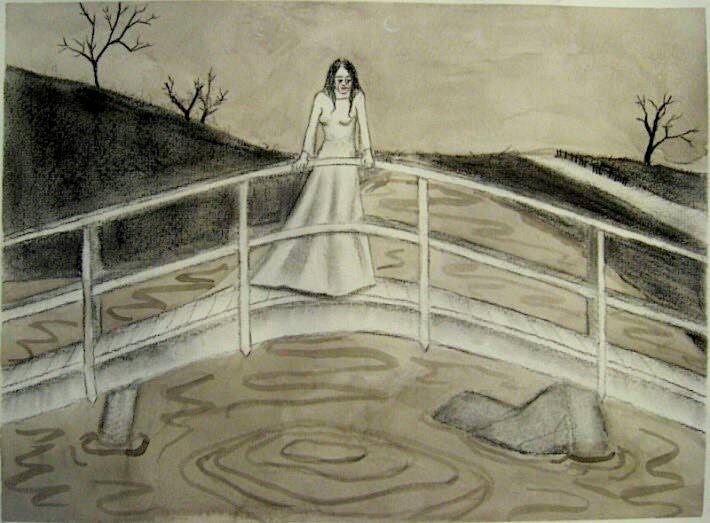
Wikimedia CommonsA malevolent ghost who portends doom and brings death, La Llorona remains one of the most terrifying figures in the folklore of Latin American and the American Southwest.
Patricio Lujan was a young boy in New Mexico in the 1930s when a normal day with his family in Santa Fe was interrupted by the sight of a strange woman near their property. The family watched in curious silence as the tall, thin woman dressed all in white crossed the road near their house without a word and headed for a nearby creek.
It wasn’t until she got to the water that the family realized something was really wrong.
As Lujan tells it, “she just seemed to glide as if having no legs” before disappearing. After reappearing at a distance far too quickly for any normal woman to have traversed, she disappeared again for good without leaving a single footprint behind. Lujan was disturbed but knew exactly who the woman had been: La Llorona.
- Who Is La Llorona, The “Weeping Woman”?
- The Historical Origins Of La Llorona
- The Most Common Origin Story Of La Llorona And Why She Killed Her Kids
- La Llorona In Pop Culture And Hollywood Films To This Day
- Terrifying Accounts Of Alleged Encounters With La Llorona
Who Is La Llorona, The “Weeping Woman”?
The legend of La Llorona, or “The Weeping Woman,” is a deeply-rooted tale in Mexican and Southwestern U.S. folklore.
Although the precise origins of the story have been lost to time, La Llorona is consistently described as a sorrowful ghostly figure who wails near bodies of water, mourning her lost children.
Some versions of the story trace her beginnings to Aztec mythology, connecting her to goddesses like Cihuacōātl, the “Snake Woman,” and Chalchiuhtlicue, who both had associations with water and child sacrifice.
Others suggest she may be a version of La Malinche, the Indigenous woman who played a crucial role during Hernán Cortés’ conquest of Mexico and is said in some retellings to have killed her children after being betrayed by Cortés.
Across different retellings, the central elements of La Lloronoa’s story remain the same: a woman, usually cloaked in a white dress and haunted by the loss of her children, weeps by the water. Her hair is long and dark, sometimes tangled or wet. Her expressions, for those unlucky enough to see them, appear monstrous due to her hollow, dark eyes and pale skin.
Legend states that anyone who crosses her path becomes cursed, experiencing a lifetime of bad luck and unending sorrow. Others believe she is a bad omen who may signal an impending catastrophe. For children, La Llorona also presents an immediate physical threat of kidnapping or violence.
But where did the story of this ghostly figure come from? In order to understand La Llorona, we have to investigate the culture of the pre-Colombian Americas.
The Historical Origins Of La Llorona
Is La Llorona Based on Aztec Mythology?
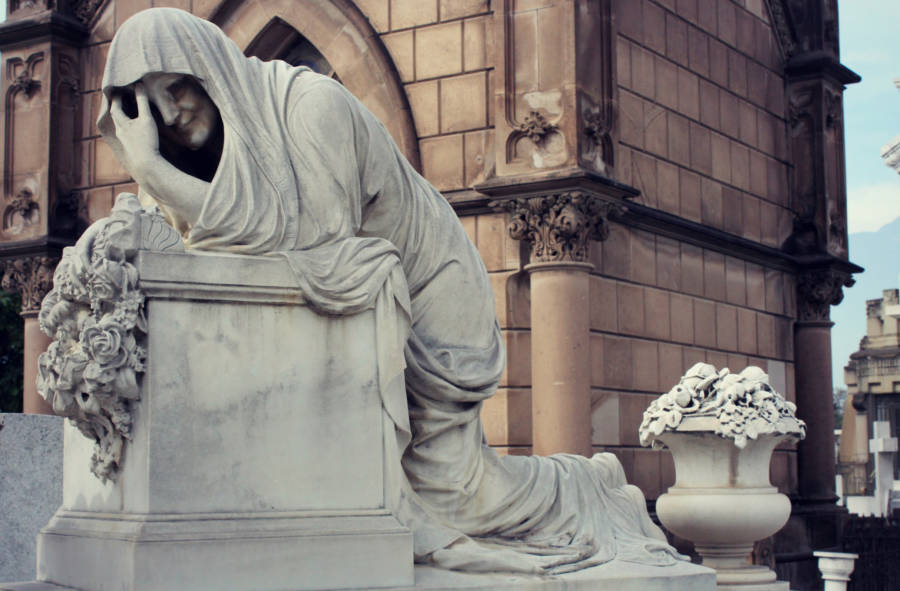
FlickrA statue of La Llorona, the murderous mother of Southwestern and Mexican folklore.
The legend of La Llorona, which translates to “The Weeping Woman,” is popular throughout the southwestern United States and Mexico. The tale has various retellings and origins, but La Llorona is always described as a willowy white figure who appears near the water wailing for her children.
Mentions of her can be traced back over four centuries, although the origins of the tale have been lost to time.
She has been connected to the Aztecs as one of ten omens predicting the conquest of Mexico or as a fearsome goddess. One such goddess is known as Cihuacōātl or “Snake Woman,” who has been described as “a savage beast and an evil omen” who wears white, walks about at night, and constantly cries.
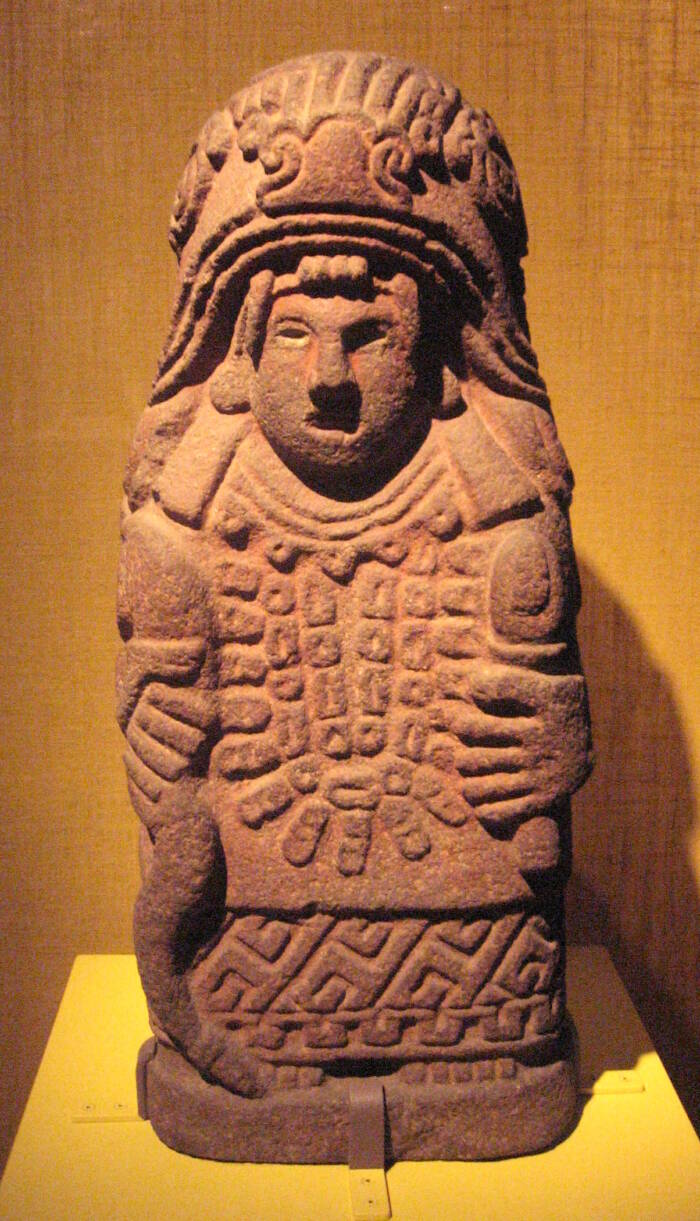
Madman2001/Wikimedia CommonsA statue of Cihuacōātl at the National Anthropology Museum c. 1325 – 1521 C.E.
Another related goddess is Chalchiuhtlicue or “the Jade-skirted one” who oversaw the waters and was greatly feared because she would allegedly drown people. In order to honor her, the Aztecs sacrificed children.
The Influence Of Hernán Cortés And La Malinche
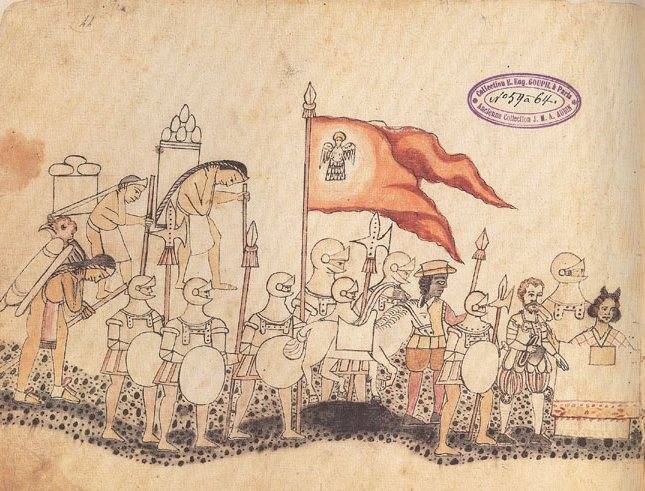
Wikimedia CommonsIn some versions of the story, La Llorona is actually La Malinche, the native woman who assisted Hernán Cortés.
An entirely different origin story coincides with the arrival of the Spanish in America in the 16th century. According to this version of the tale, La Llorona was actually La Malinche, a native woman who served as an interpreter, guide, and later mistress to Hernán Cortés during his conquest of Mexico.
The conquistador left her after she gave birth and instead married a Spanish woman. Despised now by her own people, it is said that La Malinche murdered Cortés’ spawn in vengeance.
There is no evidence that the historic La Malinche — who did in fact exist — killed her children or was exiled by her people. However, it is possible that the Europeans did bring the seeds of the legend from their homeland.
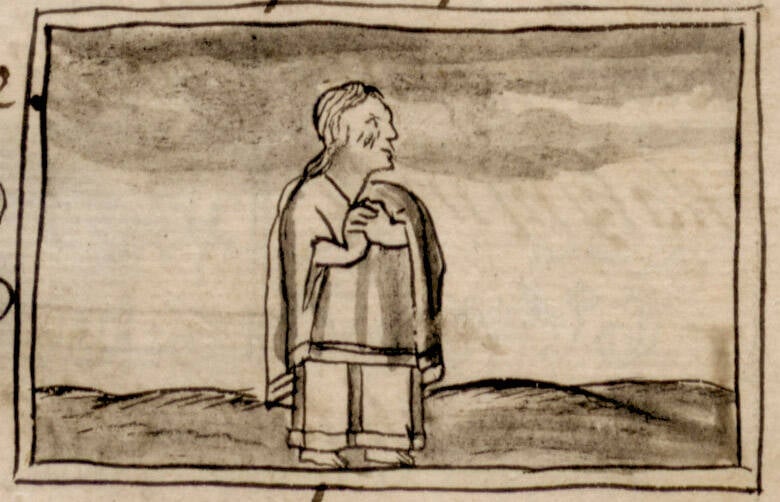
Library of CongressThis illustration of the “Weeping Woman” is found in the Florentine Codex, an ethnographic study of Mesoamerica by a Franciscan friar from Spain circa the 1570s, and it may be history’s oldest extant rendering of La Llorona.
The legend of a vengeful mother who slays her own offspring can be traced all the way back to Medea of Greek mythology, who killed her sons after being betrayed by her husband Jason.
The ghostly wails of a woman warning of impending death also share similarities with the Irish banshees. English parents have long used the tail of “Jenny Greenteeth,” who drags children down into a watery grave to keep adventurous children away from water where they might stumble in. Evidently, this terrifying figure has roots in many cultures.
The Most Common Origin Story Of La Llorona And Why She Killed Her Kids
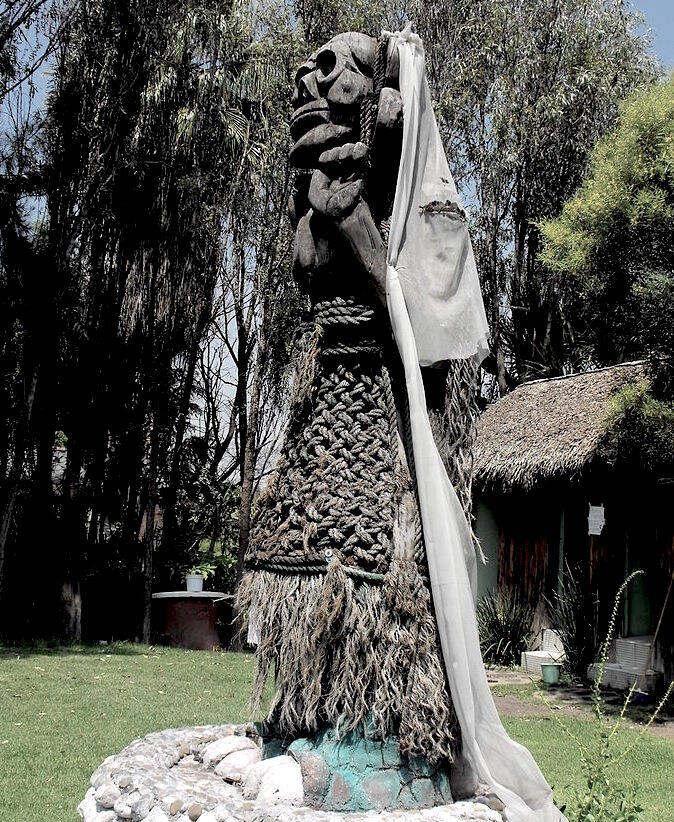
Wikimedia CommonsA statue of La Llorona in Xochimilco, Mexico.
The most popular version of the tale features a stunning young peasant woman named Maria who married a wealthy man. The couple lived happily for a time and had two children together before Maria’s husband lost interest in her. One day while walking by the river with her two children, Maria caught sight of her husband riding by in his carriage accompanied by a pretty young woman.
In a fit of rage, Maria flung her two children into the river and drowned them both. When her anger subsided and she realized what she had done, she succumbed to such profound grief that she spent the rest of her days wailing by the river in search of her children.
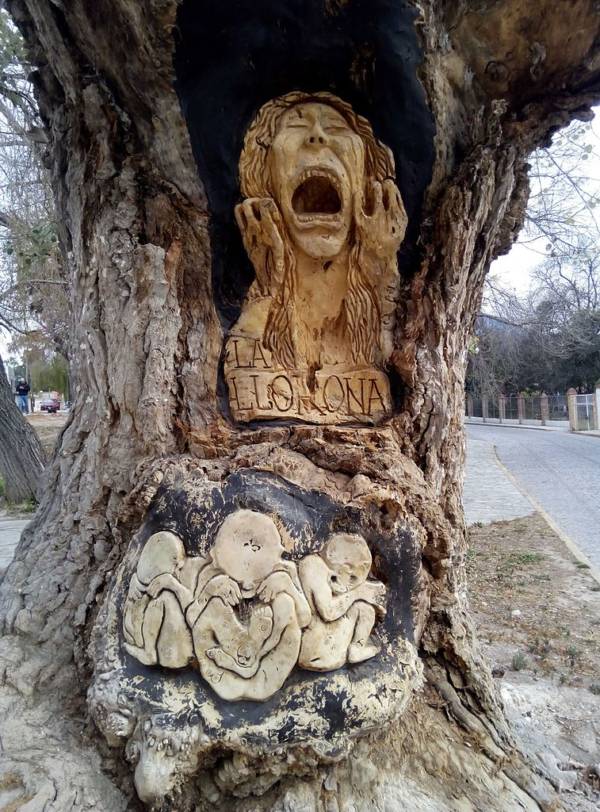
Wikimedia CommonsDepiction of La Llorona carved into a tree in Mexico.
In another version of the story, Maria cast herself into the river immediately after her children. In yet other versions, Maria was a vain woman who spent her nights reveling in town instead of tending to her children. After one drunken evening, she returned home to find them both drowned. Because of her neglectfulness, she was eternally cursed to search in vain for them throughout her afterlife.
The constants of the legend are always the dead children and a wailing woman, either as a human or ghost.
The Symbolism Of La Llorona’s Story In The Context Of Mexican Culture

Wikimedia CommonsStatues of La Llorona can be found throughout Mexico and the American Southwest.
Because nearly every origin story of La Llorona features similar descriptions of her appearance and behavior, anthropologists and historians have drawn many conclusions about what she represents in the larger cultural fabric of Mexico.
Tied closely with grief, the story of La Llorona may serve as an allegory for women’s struggles in Mexico under colonialism and even today. Some social movements in Mexico have used her story to condemn gender role expectations and ideas of traditional womanhood and motherhood.
Other groups, such as those from marginalized communities, view her as a symbol of generational trauma. Her punishment of eternally searching for her children in agony resonates with individuals who feel like they were dealt the wrong hand at birth, forever doomed to the oppressed margins of society.
However, like many other supernatural figures associated with children, La Llorona may also serve as a parental tool to keep children in line and underscore the importance of keeping to social or familial norms.

SmithsonianA doll of La Llorona from New Mexico.
Evidently, the story of La Llorona means many different things to many different people, and her appeal has proven pervasive — leading to the tale’s explosion from local legend into international sensation.
La Llorona In Pop Culture And Hollywood Films To This Day
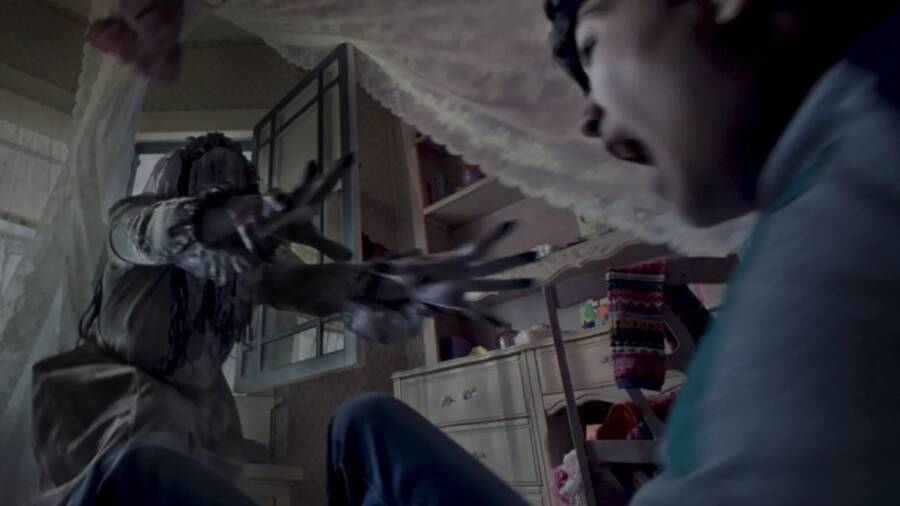
New Line CinemaA scene from the 2019 horror film The Curse of La Llorona.
Because of the overlap between La Llorona’s story and other horror mythology in both the United States and Mexico, it’s hardly surprising that her legend has found its way onto the silver screen.
The first film about the ghostly apparition was La Llorona, released in Mexico in 1933. The black and white horror film recounts the origin story of La Llorona.
Films about her were largely only made in Mexico and Guatemala until 2011, when the American film The Haunted was released, which tells the story of a family as they move into a new home haunted by La Llorona.
However, it wasn’t until 2019 that La Llorona catapulted into the zeitgeist of the American consciousness. That year, the Hollywood film The Curse of La Llorona, part of the famous Conjuring Universe, hit the big screen. The film depicted La Llorona as a tormented spirit attempting to tear apart a family. Just three years later, another film featuring La Llorona as a main character, The Legend of La Llorona, came out as well.
While many films have put their own spins on the tale of La Llorona, the main tale of a grieving woman clothed in white remains consistent — perhaps due to the large number of eyewitnesses over the years who have reported similar descriptions of this very same ghostly apparition.
Terrifying Accounts Of Alleged Encounters With La Llorona
The story of La Llorona has captured the attention of millions worldwide. What started as a regional horror story spread out into the global consciousness. No doubt the growing interest in her story stems from the thousands of real-word witnesses who claim to have encountered the terrifying spirit.
In October 2020, the Latin American news site Mitú published some of their viewers’ most horrifying personal accounts of La Llorona:
“I have lived my whole life in El Paso, Texas. The culture is rich in folklore and religious beliefs. Many Hispanic families have stories of the paranormal. One night just like any other night, I lived in a trailer with my mom and dad. My youngest brother was staying with my aunt that night.
I fell asleep watching Jay Leno as usual, and when I woke up, I was on the sofa in my living room. The time was 4:00 am which illuminated from the stove in the kitchen. The television was off, and normally I had a light on, but this time it was pitch black. I woke up, and I heard a horrible screaming that was coming from far in the distance. The screaming was coming from a ditch that was a few feet away from my home. I heard it, and I thought I was hearing things.
It sounded like I was in a big hallway, and a woman was screaming her guts out down that hallway. Then in all the screaming, I started to make out words. These words being said by whoever this was at 4 a.m. screaming their guts out, shocked me. The woman said, ‘¡Ay, mis hijos!’ (Oh, my children!).
To this day, I don’t care what people think of my experience. I know what I heard. A couple of years later, it happened to me again.”
Another bone chilling account of La Llorona read:
“My mom is from a small town in Mexico located in Zacatecas. When she was around 14, she had the habit of waking her mom up to go to the restroom since it was an older home and the restroom was located outside. My mom told me that it was around 3 AM when she woke up and felt the need to use the restroom urgently. So she began calling out for her mom.
After a while of her mom not responding, she began getting agitated and started screaming. At this point, my mom turns around, and at the foot of her bed, she sees her mom standing there. She was wearing a white robe but had a very bleak expression on her face & both of her arms were extended.
My mom said that she suddenly felt extremely cold and had a huge sense of dread. She had never seen her mom wear a white robe…that’s when she looked down and saw her ‘mom’s’ feet weren’t touching the floor. At that moment, she screamed and quickly threw the covers over her head. Her mom wearing something completely different, runs in to find my mom shaking in her bed. Nobody believed my mom; everyone told her it was a dream.
Until a few days later, there was a power outage. During this, my mom and a few of her siblings with her parents all decided to sleep in the living room. At around the same time at 3 AM, they heard the same undeniable wails of La Llorona down their street. None of them slept that night.”
With more chilling accounts like these appearing every year, the story of La Llorona only becomes more deeply ingrained in popular culture and folklore worldwide.
What is the story of La Llorona and why does she cry?
In the story’s most common telling, La Llorona was a woman who found out that her husband had been unfaithful, then drowned their children in a fit of rage before killing herself. She’s said to always be crying, eternally plagued by the sorrow and grief of these events.
Why did she drown her children?
Though most stories indeed say that La Llorona killed her children after discovering her husband’s infidelity, other tellings say that she herself was unfaithful and bore a son out of wedlock, who she then killed so her husband wouldn’t find out.
What is La Llorona’s real name?
“La Llorona” is Spanish for “The Weeping Woman,” and her real name is typically unknown in the legend. In some variations of the story, she is referred to as Maria, a common name in some versions of the tale, though it’s thought to be symbolic of many grieving mothers.
Where have sightings of her occurred?
La Llorona is most commonly seen in regions throughout Mexico, Central America, and the Southwestern United States, almost always near rivers, lakes, or other bodies of water. She has been sighted in areas like the Rio Grande, the waters around Zacatecas, and parts of New Mexico.
Was the legend inspired by a real person?
Some say the story of La Llorona comes from the real, historical figure, La Malinche, the native Mexican concubine and interpreter to Hernan Cortes. Cortes allegedly left her for a Spanish woman and in revenge, La Malinche killed their children.
After learning about La Llorona, read about some of the most haunted places in the world. Then, learn about Robert the Doll, perhaps the most haunted toy in history.





